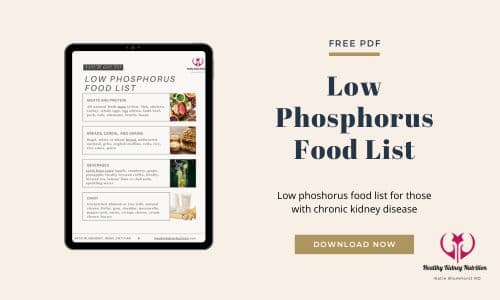Sharing is caring!
Table of Contents
A Comprehensive Guide to Low Phosphorus Foods
This blog post will explore a list of low-phosphorus foods that can help you maintain optimal health.
Managing phosphorus intake is crucial for individuals with kidney disease or those who need to maintain healthy phosphorus levels for other health reasons.
A high phosphorus level in the blood overtime can lead to bone and heart problems, especially for people with compromised kidney function.
Therefore, adhering to a low phosphorus diet can make a significant difference in health outcomes.
Read on and you’ll be able to download your free Low Phosphorus Food List below.
Understanding Phosphorus and Its Importance
Phosphorus is a mineral found in many foods. It plays a critical role in the formation of bones and teeth, and it’s also one of the essential nutrients for the body’s use of carbohydrates and fats.
Phosphorus helps in the production of protein for the growth, maintenance, and repair of cells and tissues.
However, too much phosphorus can be detrimental, especially for those with kidney issues, as the kidneys are less able to remove excess phosphorus from the blood.
When phosphorus levels are high, calcium is pulled from the bones, causing the bones to become weak and breakable.
That calcium floats in the bloodstream and is deposited in soft tissues like the heart, lungs, blood vessels, eyes and skin. This can lead to heart disease and other health complications.
If phosphorus levels remain high even with a low phosphorus food choices, a medication called phosphate binders can be used. These are taken with meals and snacks and absorb phosphorus in foods and is excreted in the stool.
Your doctor will need to prescribe the phosphorus binder medication.
Low Phosphorus Food List Categories
Fruits and Vegetables
Fruits and vegetables are generally low in phosphorus and are an excellent choice for a healthy diet. Here are some options:
- Fruits:
- Apples
- Berries (strawberries, blueberries, raspberries)
- Grapes
- Pineapple
- Watermelon
- Vegetables:
- Cabbage
- Cucumber
- Bell peppers
- Lettuce
- Zucchini
These fruits and vegetables not only provide essential vitamins and minerals but also contribute to overall health without adding excessive phosphorus to your diet.
Grains and Cereals
Whole grains and certain cereals can be good choices for those needing to limit their phosphorus intake. Some options include:
- White rice
- Pasta
- White bread
- Oatmeal (in moderation)
- Corn or rice-based cereals
While whole grains are generally healthier, they contain more phosphorus.
Protein Sources
Proteins are a necessary part of any diet, but many high-protein foods are also high in phosphorus. Here are some low-phosphorus protein sources:
- Chicken and turkey (without skin)
- Fish such as tilapia, cod, and haddock
- Eggs (especially egg whites)
- Tofu
- Beef and pork (in limited quantities)
Lean meats and alternative protein sources like tofu are excellent choices to maintain protein intake while managing phosphorus levels.
Dairy and Alternatives
Dairy products are typically high in phosphorus, but there are low-phosphorus options available:
- Rice milk (unenriched)
- Almond milk (unenriched)
- Cream cheese
- Butter
- Sherbet
While many plant-based milks are fortified with phosphorus, choosing unenriched varieties can help keep phosphorus intake low.
Snacks and Sweets
Indulging in snacks and sweets doesn’t have to be off-limits. Here are some low phosphorus options:
- Popcorn (unsalted and unbuttered)
- Pretzels
- Jelly beans
- Hard candies
- Fruit snacks
These snacks can satisfy your cravings without adding a significant amount of phosphorus to your diet.

Tips for Managing Phosphorus Intake
- Read Labels: Check food labels for phosphorus content. Phosphorus is often added to processed and packaged foods. Ingredients like “phosphates” or “phosphoric acid” indicate the presence of phosphorus. The foods with added phosphates contain the most phosphorus than foods that have natural phosphorus or organic phosphorus. The body will absorb 100% of the phosphorus coming from added sources and only about 50% of natural sources of phosphorus.
- Cook at Home: Preparing meals at home allows you to control the ingredients and phosphorus content. Eating out and consuming fast food often have added phosphorus which can increase phosphorus levels.
- Consult a Dietitian: A registered dietitian can provide personalized advice and meal plans to help you manage your phosphorus intake effectively. You can find a renal dietitian in your area at the National Kidney Foundation CKD Kidney Dietitian Directory
- Monitor Portion Sizes: Even low-phosphorus foods can contribute to high phosphorus levels if eaten in large quantities.
Conclusion
Managing phosphorus intake is essential for maintaining health, particularly for those with kidney disease. By incorporating low-phosphorus foods into your diet, you can enjoy a variety of delicious and nutritious meals while keeping your phosphorus levels in check.
Remember to consult with a renal dietitian to tailor your diet to your specific health needs. With careful planning and mindful eating, you can achieve a balanced diet that supports your kidney health.
- The Renal Warrior Project. Join Now
- Source: https://healthykidneynutrition.com/low-phosphorus-food-list/
